Imagine a world where organizations effortlessly adapt to shifting market conditions, seize opportunities, and thrive in the face of adversity.
Sounds too good to be true?
Well, this could be your organization’s reality with the help of adaptive change management. In this blog post, we will explore the intricacies of adaptive change, the crucial role of adaptive change leaders, and how to implement this powerful strategy in your organization.
As the business environment becomes increasingly unpredictable, adaptive change management has emerged as a vital tool for organizations to stay competitive and resilient.
Are you ready to embark on this exciting journey?
Let’s dive in and unlock the full potential of your organization through adaptive change management.
Short Summary
- Adaptive change management is a flexible approach to managing organisational change. Adaptive change is essential for businesses to stay competitive and successful.
- Adaptive leaders play a crucial role in managing change. Leaders need skills to balance perspectives, manage conflict & resistance, engage stakeholders and develop plans when implementing adaptive change management.
- Real life examples demonstrate how adaptive change can help organizations become agile, responsive & innovative.
Understanding Adaptive Change

Now, you might wonder how adaptive change differs from its counterpart, technical change. While both are essential for organizational success, they have distinct characteristics that set them apart.
Let’s explore these differences in the next section and understand their unique roles in driving change initiatives.
The Importance of Adaptive Change
Adaptive change enables organizations to tackle complex challenges, foster innovation, and stay ahead of the competition.
A well-executed change initiative can lead to significant improvements in organizational performance and resilience. However, implementing adaptive changes often requires navigating through uncertainty and addressing external threats.
On the other hand, managing the stress of employees during a significant organizational change is a colossal challenge for leaders. Reducing resistance is crucial when implementing adaptive change, and it involves open communication, involving employees in decision-making, and fostering a growth mindset.
Effective conflict management also plays a key role in the success of adaptive change initiatives.
Adaptive vs. Technical Change
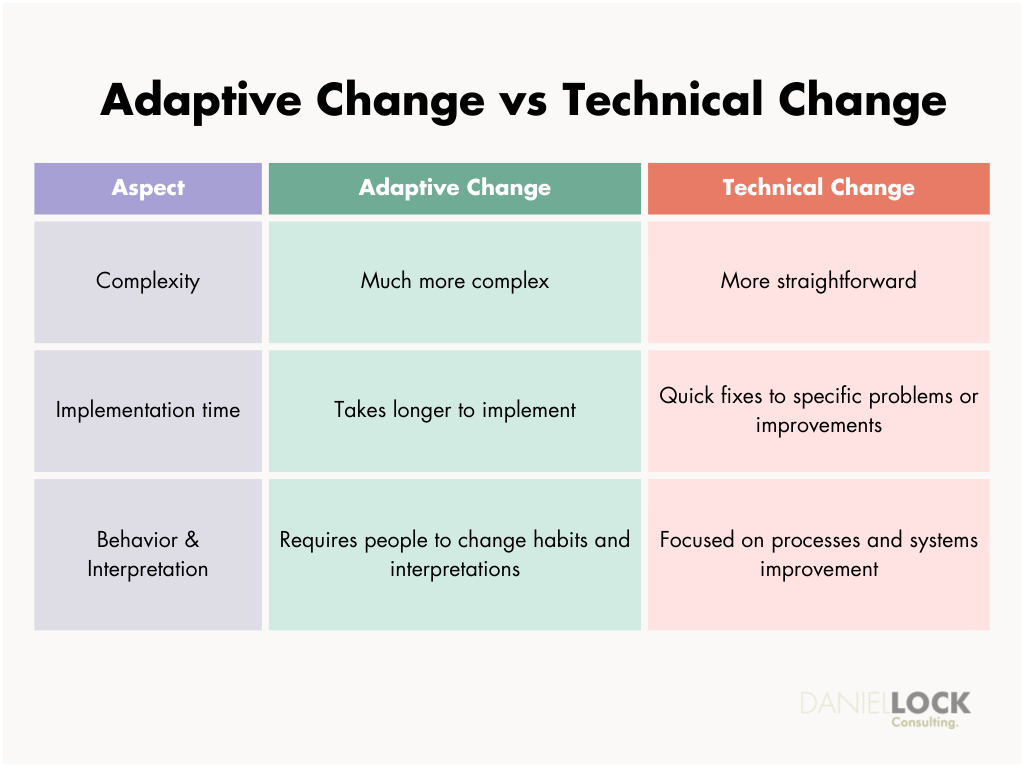
While adaptive and technical change are essential components of organizational development, they differ in several aspects. Adaptive change is more complex, takes longer to implement, and requires people to change their habits and interpretations.
On the other hand, technical change is more straightforward, involving quick fixes to specific problems or improvements to existing processes.
Understanding the contrast between adaptive and technical change can help leaders come up with more efficient solutions and drive change initiatives strategically.
For instance, a power outage at a waste management facility would be a technical change, while a shift in company culture to embrace diversity and inclusion would be an adaptive change.
Now that we have a grasp of adaptive change, let’s delve into the role of adaptive leaders in managing such change.
The Adaptive Leader
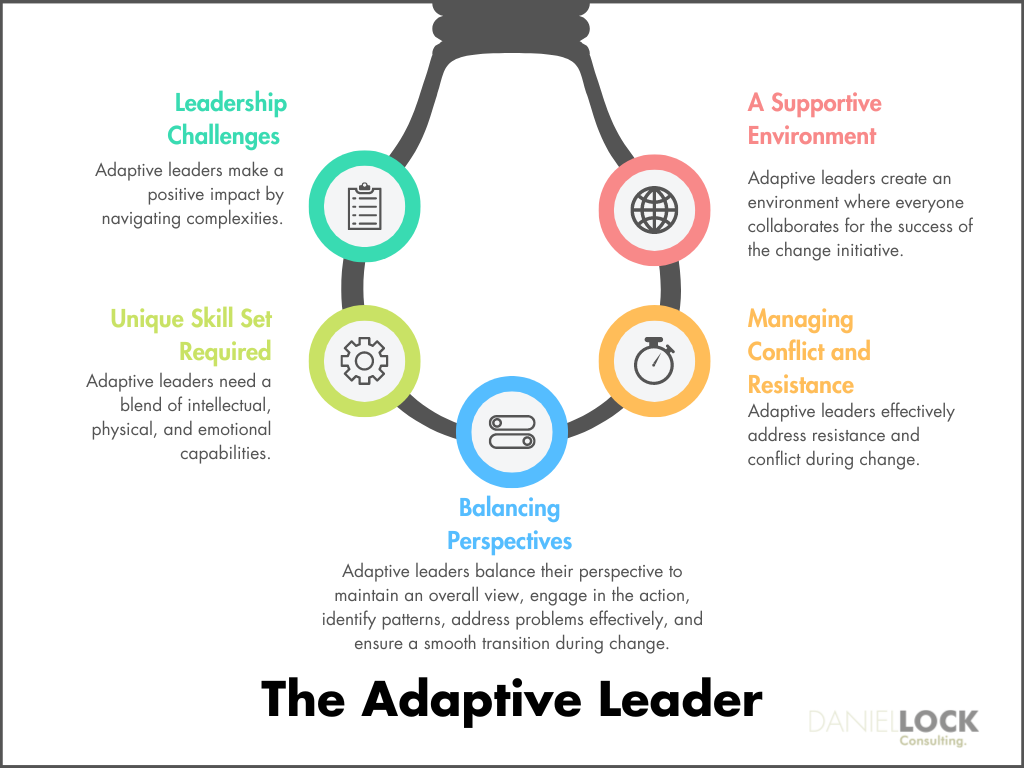
Leading adaptive change is no easy feat. It takes a special kind of individual to embrace the challenges of leadership and make a positive impact on the lives of others.
Adaptive leaders must possess a unique blend of intellectual, physical, and emotional capabilities to drive organizational development and successfully navigate through the complexities of change.
A crucial aspect of adaptive leadership is the ability to balance perspectives, maintaining a bird’s-eye view of the situation while still being involved in the action. This skill enables leaders to spot patterns and tackle problems more effectively, ensuring a smooth transition during the change process.
Let’s explore how adaptive leaders can strike this balance and manage conflict and resistance in the next sections.
Balancing Perspectives
Having a balanced perspective is essential for adaptive leaders, allowing them to:
- Maintain an overall view of the situation
- Be involved in the action
- Spot patterns
- Tackle problems more effectively
- Ensure a smooth transition during the change process.
So, how can leaders strike this balance?
Taking a break to look at the situation from a wider perspective can help leaders spot patterns and potential solutions that they may have missed if they were too focused on the action.
This different approach enables them to identify common themes or trends in the data and come up with strategies for resolving issues, ultimately leading to a more successful change initiative.
Managing Conflict and Resistance
During the adaptive change process, leaders may encounter resistance and conflict from employees and stakeholders. Addressing these issues is crucial for the success of the change initiative.
Adaptive leaders can overcome resistance by providing clear communication, addressing concerns promptly, and involving stakeholders in dialogue.
By fostering open communication and focusing on solutions instead of assigning blame, adaptive leaders can address conflicts constructively and help stakeholders see the benefits of change.
In doing so, they create a supportive environment where employees and stakeholders can collaborate and contribute to the success of the change initiative.
Implementing Adaptive Change Management
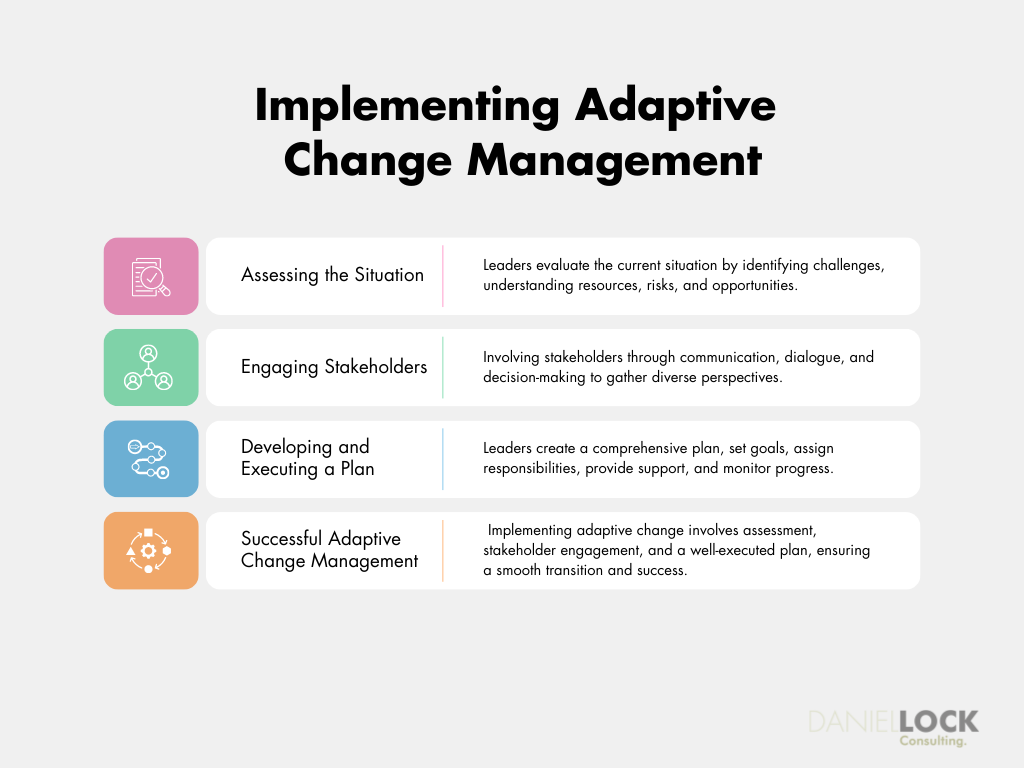
To successfully implement adaptive change management, leaders need to follow a structured process, based on principles, that involves assessing the current situation, engaging stakeholders, and developing and executing a plan.
This process ensures that the organization is well-prepared for the change and that the transition is as smooth as possible.
Involving all relevant stakeholders in the change process is crucial for the success of adaptive change management.
By engaging stakeholders, leaders create a more comprehensive understanding of the change process and ensure that all relevant perspectives are considered.
In the next sections, we will explore the steps involved in implementing adaptive change management in more detail.
Assessing the Situation
Evaluating the current situation is the first step in implementing adaptive change management. Leaders must:
- Identify the challenges their organization faces
- Determine the need for adaptive change
- Understand the given situation
- Assess the resources available
- Identify potential risks
- Identify opportunities for improvement
By thoroughly assessing the situation, leaders can develop a clear understanding of the challenges their organization faces and the changes that need to be made to address these challenges.
This information can then be used to create a comprehensive plan for implementing adaptive change, ensuring that the organization is well-prepared for the transition.
Engaging Stakeholders
Involving stakeholders in the change process is essential for the success of adaptive change management. Engaging stakeholders helps create a more comprehensive understanding of the change process and ensures that all relevant perspectives are considered.
This can be achieved by providing stakeholders with information, statistics, engaging in dialogue, and involving them in decision-making.
Creating a safe space for honest conversations and collaboration is also crucial for engaging stakeholders and overcoming resistance. By fostering trust and encouraging commitment to the change process, leaders can ensure that the transition is smooth and that the organization is well-prepared for the challenges ahead.
Developing and Executing a Plan
With a clear understanding of the challenges and the need for adaptive change, leaders must create a comprehensive plan for implementing adaptive change in their organization. This plan should include setting goals, assigning responsibilities, and monitoring progress.
Executing the plan involves providing the necessary support, resources, and guidance to ensure the change is successful. By rolling out the change execution with a support plan in place and offering engagement sessions and training, leaders can help everyone adopt the change and contribute to its success.
Overcoming Common Challenges in Adaptive Change Management
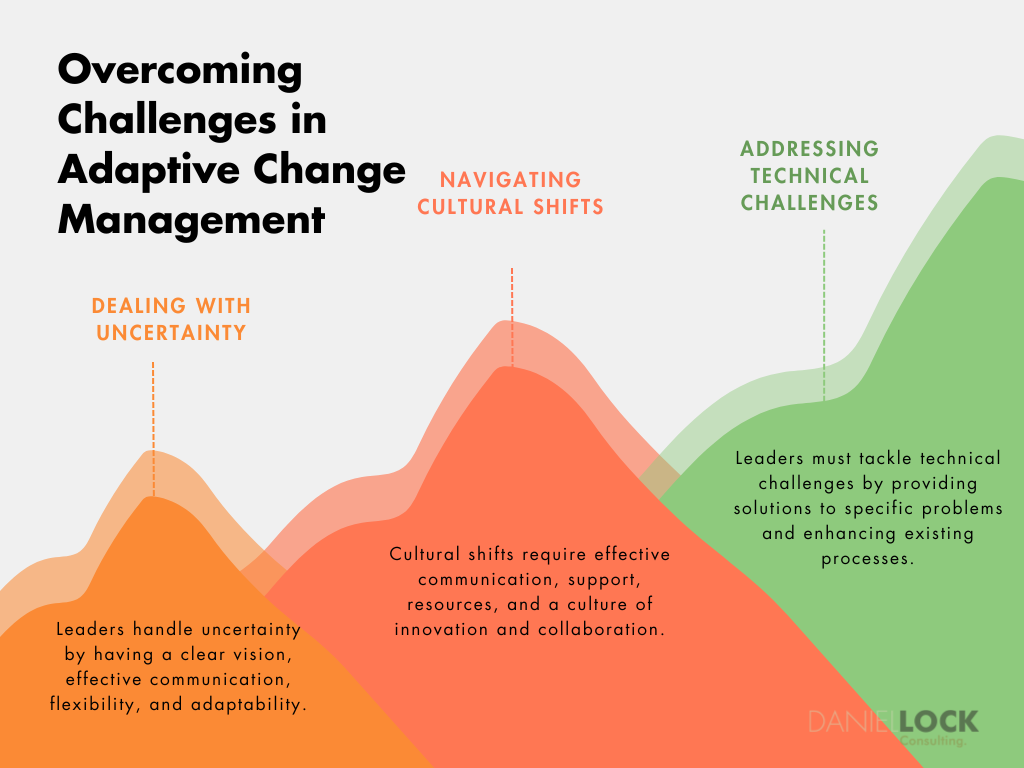
Adaptive change management is not without its challenges. Leaders often face obstacles such as taking ownership of the changes, challenging the status quo, and understanding the difference between technical and adaptive challenges.
To overcome these challenges, leaders must create a shared vision, involve stakeholders, and foster trust.
In the next sections, we will discuss strategies for dealing with two common challenges in adaptive change management: uncertainty and navigating cultural shifts, as well as addressing technical challenges.
Dealing with Uncertainty
Uncertainty is an inherent aspect of adaptive change, as the process often involves making decisions based on evolving circumstances. To deal with uncertainty, leaders must have a clear vision and plan, communicate effectively, and be flexible and open to change.
Creating contingency plans, keeping an eye on changes in the environment, and staying open to new ideas and approaches can help leaders navigate the uncertainty of adaptive change.
By being prepared to adapt and make decisions based on changing circumstances, leaders can ensure their organization remains competitive and successful.
Related: 10 Best AI Tools for Change Management
Navigating Cultural Shifts
Implementing adaptive change may require significant cultural shifts within the organization. Leaders must effectively communicate the need for change and support employees through the transition.
Fostering a growth mindset and a learning culture is crucial for employees to be open to new ideas and embrace change.
Providing employees with the necessary resources, guidance, and a supportive work environment can help them adjust to the changes and improve their performance.
By cultivating a culture of innovation and collaboration, leaders can ensure that their organization successfully adapts to the changing business environment.
Real-Life Examples of Adaptive Change
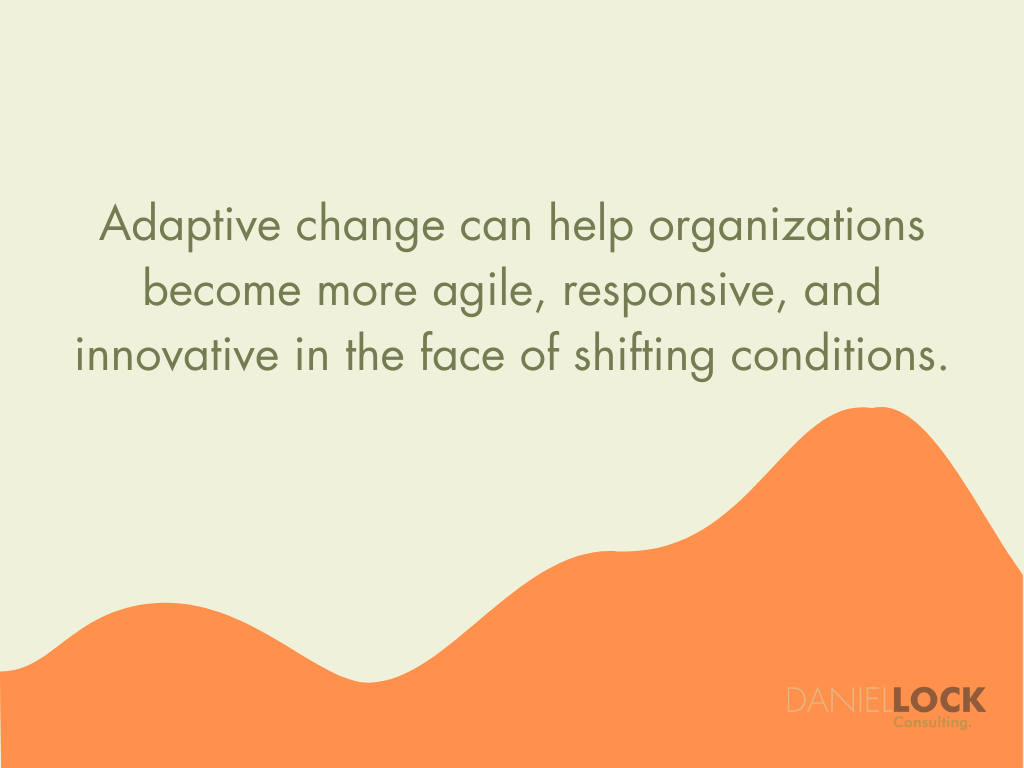
Now that we have a solid understanding of adaptive change and how it can be implemented, let’s take a look at some real-life examples that demonstrate the impact of adaptive change on organizations.
These examples highlight how adaptive change can help organizations become more agile, responsive, and innovative in the face of shifting conditions.
Whether it’s resolving interpersonal conflicts in the workplace, adjusting to a new manager, or following the footsteps of visionary leaders like Abraham Lincoln who embraced diversity and change, adaptive change can have a profound effect on organizational success and pave the way for a promising future.
Let’s explore two specific examples of adaptive change in action.
Adaptive change management is a crucial concept in today’s fast-paced and ever-evolving business environment. Here are two case studies that exemplify the definition you provided:
Netflix’s Evolution from DVD Rentals to Streaming:
Background: Netflix started as a mail-order DVD rental service in 1997. By the mid-2000s, they had a successful business model based on mailing DVDs to subscribers.
Adaptive Change: As broadband internet became more widespread, Netflix recognized the potential of streaming media. Instead of sticking to their original model, they began investing heavily in streaming technology and content.
This was a significant shift and required the company to adapt to new technologies, customer behaviors, and market conditions.
Outcome: Today, Netflix is a global streaming giant with original content in multiple languages. Their ability to foresee the shift in media consumption and adapt their business model accordingly is a classic example of adaptive change management.
LEGO’s Business Transformation:
Background: LEGO, the beloved toy brick company, faced near bankruptcy in the early 2000s. They had diversified too much into areas like theme parks, clothing, and video games, diluting their core brand.
Adaptive Change: Recognizing the need for change, LEGO embarked on a transformation journey. They refocused on their core product, the LEGO brick, and began engaging with their user community more actively.
They also started collaborating with franchises like Star Wars, Harry Potter, and Marvel, which resonated with both old and new fans.
Outcome: By the 2010s, LEGO had not only recovered but was thriving.
Their adaptive approach to change, which involved both returning to their roots and innovating in ways that resonated with their audience, saved the company.
—
Both of these case studies highlight the importance of recognizing changing conditions and being flexible in response.
They also emphasize that adaptive change management is not just about reacting to external changes but also about understanding one’s core strengths and leveraging them in new and innovative ways.
As a result of implementing adaptive change, the company saw improvements in employee performance. The new workflows increased collaboration, and the additional resources and support empowered employees to perform at their best.
This example highlights the potential of adaptive change to drive positive outcomes in organizations.
Building the Skills for Adaptive Change Management
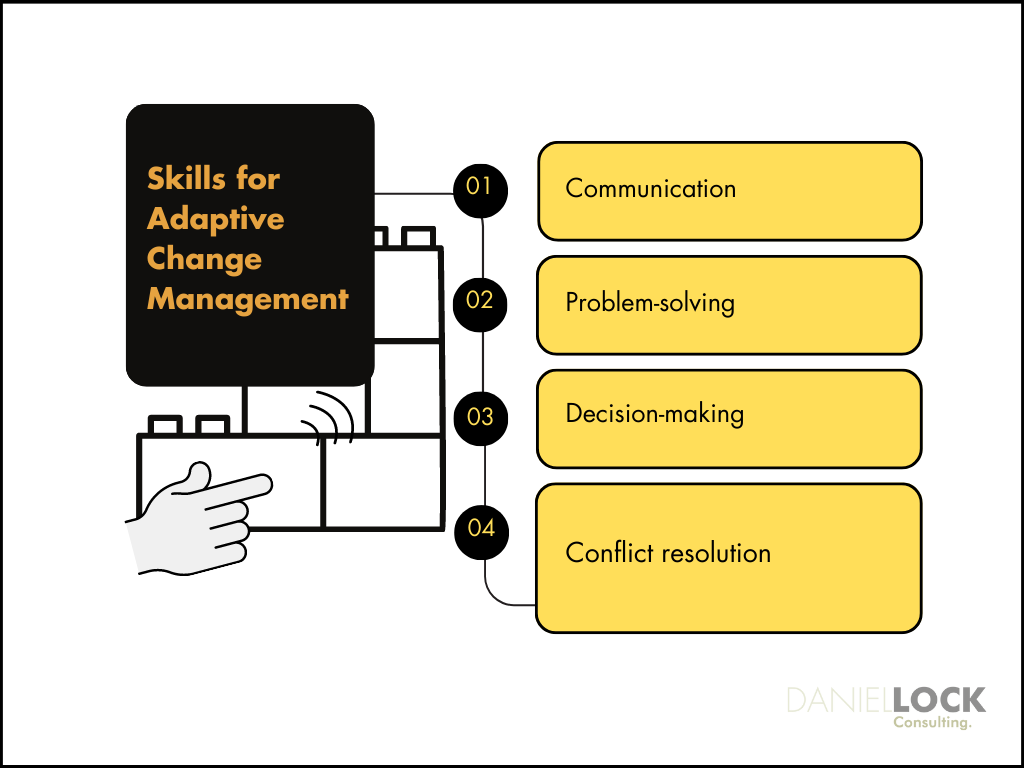
Developing the necessary skills for adaptive change management is crucial for leaders to successfully handle organizational change. Managers need strong skills in:
- Communication
- Problem-solving
- Decision-making
- Conflict resolution
Experience and on-the-job training alone are not sufficient to effectively manage change, as they may eventually fail to address unforeseen challenges.
To build these skills, leaders can invest in management training courses, programs, and workshops. By honing their adaptive change management skills, leaders will be better equipped to navigate the complex challenges of organizational change and drive their organizations to new heights of success.
Summary
In conclusion, adaptive change management is a powerful tool that enables organizations to stay competitive and resilient in an ever-changing business environment.
By understanding the nuances of adaptive change, developing the necessary skills, and effectively implementing adaptive change initiatives, leaders can drive their organizations to new heights of success.
So, are you ready to embrace adaptive change and unlock your organization’s full potential?
Frequently Asked Questions
What is the goal of adaptive change?
The goal of adaptive change is to help organizations survive and prosper in an ever-evolving environment by introducing permanent changes to their strategy, structure, and processes.
What are the 6 principles of adaptive work?
Adaptive Leadership is based on six key principles: focusing on the big picture, understanding context, enabling collaboration, learning and adapting, embracing experimentation, and making decisions.
These principles help leaders better understand the complexities of dynamic environments and foster a culture of successful problem solving.
What is the difference between transformational change and adaptive change?
Transformational change is a dramatic evolution of some basic structure of a business, whereas adaptive change happens incrementally over time. Transformational change is often sudden and drastic, while adaptive change are small, incremental changes that usually take place internally.
What are the 4 stages of adaptive leadership?
Adaptive leadership has four distinct stages: emotional intelligence, organisational justice, development and character. All of these elements are essential for successful leadership.
What is the meaning of adaptive changes?
Adaptive change is the process of making small, incremental adjustments to adapt to daily, weekly, and monthly business challenges that require new learning and problem solving. It can involve experimenting with new approaches and practices to address complex and nebulous issues.




